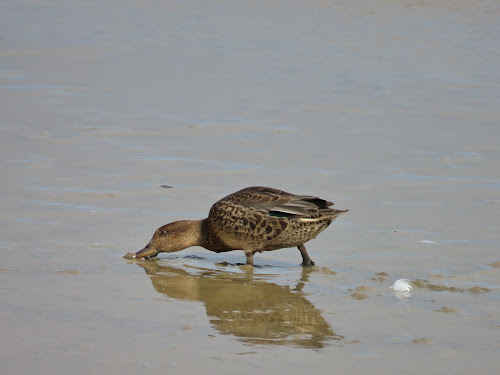With Cley done it was inevitable that I should spend my second day in North Norfolk at Titchwell. Similar to Cley, Titchwell is an expanse of reedbeds, scrapes and beach, that provides a haven for many birds, often attracting some unusual ones. Its a great place for WADERS, and a trip at this time of year usually guarantees a sight of some of the scarcer common species. But with winds not being particularly kind (the sort that would blow a rare migrant off course), and with not much being about in particular, I wasn't expecting much.
Having take nthe bus, I stepped off, outside the reserve, and walked within, with that air of expectation as to what I'm going to see. The footpath through the reserve is one long line which runs perpendicular from the car park, with its visitors centre (and a nice coffee), to the beach. It traverses a succession of habitats that range from woodland around the car park, through reeds, freshwater scrapes, tidal systems, before eventually finishing at the beach and the sea, the natural end point for all habitats on this island.
As you would expect from this time of year, the reedbed was quiet, the pools holding small numbers of ducks. A GREAT WHITE EGRET was about turning up at different points at the reedbed pools, preferring the deeper water found within the reeds, to the shallower water present further on.
It wasn't until I got to Freshwater Marsh that things stared getting interesting. This body of shallow water is the best point of the reserve, where mud caused by receding water levels over the summer attract plenty of DUCKS and WADERS. However, recent habitat management has meant large diggers were working here, which has scared away the ducks but the waders didn't seem to mind, even though they kept a safe distance. The habitat management is taking place to create more islands for nesting waders, particularly AVOCETS, and doing it at this time of year results in less disturbance, rather than doing it in the breeding or wintering seasons.
And on Freshwater Marsh there were plenty of AVOCETS lingering from the breeding season, and with the work going on, they will only increase. Also about were usual collection of WADERS you would expect to see on a North Norfolk scrape. These birds will be on Autumn migration, heading away from breeding grounds to their wintering ones. Most populous were RUFF with around 50 present, lots of BLACKWITS and 15 GOLDEN PLOVERS a good number for the time of year. Just as at Cley a CURLEW SANDPIPER was present in a flock of the similar looking DUNLIN, as they always seem to at this time of year, birds often join flocks of similar looking species, I guess because they are just lonely, at a site like this on their own, they just want to make friends.
Also present on Freshwater Marsh, on the exposed mud before the reeds, was a juvenile WATER RAIL, a common bird of reedbeds, they're just so bloody hard to see! They spend all their time skulking about and never like being away from cover for long. They have a call like a screaming pig, which you hear quite often erupting out of the reeds.
As the path gets closer to the beach it passes a series of tidal pools, designed to reduce the pressures of rising sea levels on the reserve. Volunteer Marsh was looking good and has now become overgrown with saltmarsh, which is good as its fairly new in construction. However, there were few birds on these pools, so it was a further trudge to the beach.
And then it comes on you unawares, the climax of the walk down the reserve, the beach itself. The path walks out on the dunes, and there you are hit by an endless horizon, sand for miles and miles in both direction, with the sea in front of you, making you pine for the safe closeted land of the nature reserve.
On the edge of the sea water WADERS fed, different kinds to the ones found on Freshwater Marsh. Here are the species that enjoy a saltier snack. They particularly enjoyed a mussel bed exposed by the receding tide. BAR TAILED GODWIT, CURLEW, OYSTERCATCHER, REDSHANK, TURNSTONE and SANDERLING were about. The latter are a grey/white colour and run up and down the tide line looking like wind-up toys.
To get away from the beach its the same walk back again to the visitors centre. Just off the main path, back near the car park, a small trail along a boardwalk takes you through reeds until you get to Patsy's Pool, an artificial pool now returned back to reedbed, Here all the WATERFOWL had concentrated, mainly GADWALL, but with plenty of COOT, SHOVELLER and POCHARD. The GREAT WHITE EGRET was also about stalking any fish that happened to be out in the open.
A quiet time at Titchwell then, but you can't really expect more. Birds are never very predictable at the best of times, which makes watching them so interesting, if frustrating. August is always low energy, a lazy time of little consequence to the birds. The usual were about, there were no surprise omissions, it was just business as usual. And that is a sort of satisfactory thing to report.










No comments:
Post a Comment